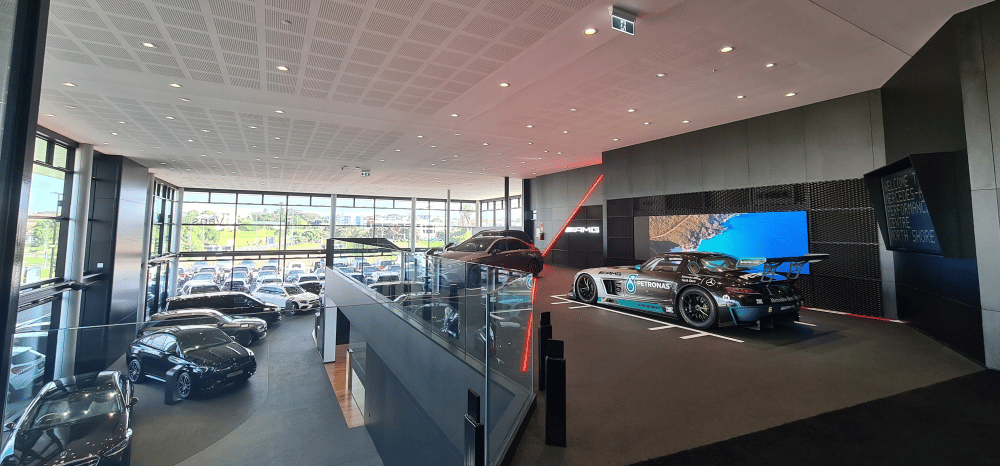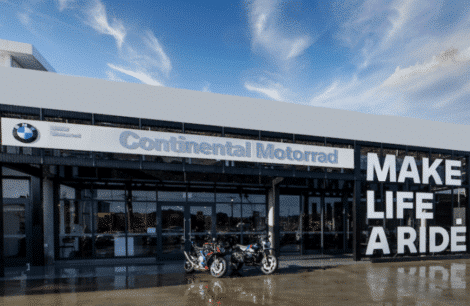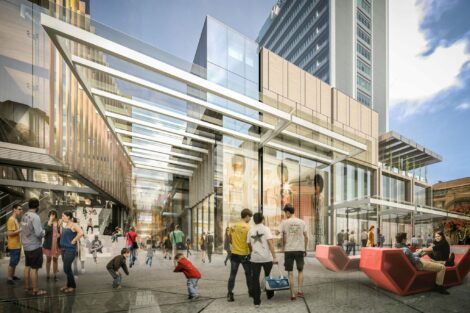
In the modern retail environment, lighting control has become far more than a technical necessity. It is a fundamental part of the brand experience, a subtle yet powerful tool for influencing customer behaviour, and a critical element of operational efficiency. As physical stores face increased competition from online retail, the in-store experience must offer something digital shopping cannot: atmosphere, engagement, and a sense of connection. Lighting, when intelligently controlled, has the power to transform a store from a simple point of sale into a destination, enhancing both the emotional impact of the brand and the functional performance of the space.
At Intelligent Environments, we have seen first-hand how lighting control can change the way a retail space works – for customers, for staff, and for the business as a whole. Our work spans high-end showrooms, large-format warehouse stores, flagship retail developments, and specialist fit-outs, each with their own challenges and opportunities. While the products, customer base, and brand messages differ, the common thread is that lighting control plays a strategic role in how the space is perceived, how efficiently it operates, and how well it adapts over time.
The opening of the new BMW Motorrad showroom on Auckland’s North Shore in July 2023 was a prime example. Positioned alongside New Zealand’s largest BMW car dealership, the space was designed as a true destination for motorbike enthusiasts – the first in the country to feature BMW Motorrad’s “Make Life a Ride” corporate identity. This was not just a place to display motorcycles; it was a space to immerse visitors in the BMW lifestyle, with ride-and-style areas, heritage displays, and a retail selection of helmets, apparel, and accessories. The lighting control system had to be robust enough to handle staged commissioning, as the building was handed over in phases, yet flexible enough to adapt to the different zones and their specific purposes. We installed a zencontrol DALI-2 system, integrating sensors and switches to manage lighting in offices, meeting rooms, and service areas, while using DALI RGBW fittings and DMX control for exterior displays. This allowed for colour-changing effects and pre-set scenes that could be tailored for events or promotions, with up to 192 DMX channels available – a cost-effective yet highly capable solution for a premium brand. The result is a showroom where lighting is both understated and impactful, supporting the customer journey while maintaining operational efficiency behind the scenes.


While BMW Motorrad represented a boutique, brand-driven retail environment, the opening of Costco’s first New Zealand store in September 2022 showcased the other end of the scale: a high-volume, large-format “big box” retail operation requiring a robust, practical, and highly coordinated approach. The Westgate store covers a vast footprint and incorporates a wide variety of areas, from the main warehouse floor to optical and pharmacy services, each with their own lighting needs. Our role, working with Dickson Gray Electrical, was to design and commission a system that could integrate a mix of DALI and relay-controlled lighting, manage dimming where appropriate, and interface with the store’s alarm system for controlled opening and closing sequences. This staging was more than a convenience; it was essential to reducing inrush current and protecting the infrastructure. In a building of this scale, local control is as important as central oversight, so we provided smart switches for the manager’s office along with distributed switches and sensors throughout the store, ensuring that each area could be managed independently while still contributing to the store’s overall energy and operational efficiency.

In mixed-use retail developments such as Commercial Bay, the requirements become even more complex. Here, the lighting control system must cater to a blend of public spaces, architectural features, and multiple tenant fit-outs, each with its own brand requirements and operational hours. The system must deliver consistency and efficiency in common areas while allowing tenants the flexibility to manage their own spaces. Our approach in these environments is to use open-protocol DALI systems that can integrate with central building management while enabling granular control for each tenant. This ensures that the development as a whole operates efficiently and sustainably, while the individual retailers can still deliver brand-specific experiences to their customers.
Not all retail control projects are about the overall environment; sometimes they address a very specific operational challenge. In the case of Kathmandu, the requirement was for a call-for-assistance system in fitting rooms – a feature that directly impacts customer service and staff responsiveness. We supplied a Rapix plug-and-play solution, requiring no on-site commissioning, that allowed customers to request help with a simple button press. Indicator lights both outside the cubicle and on the shop floor alerted staff, who could reset the system once assistance was provided. This solution, rolled out to new stores in Newmarket and Christchurch, improved service efficiency without adding complexity to store operations, demonstrating that intelligent control can be just as valuable in small, targeted applications as it is in whole-store systems.
The variety of these projects illustrates the adaptability of intelligent lighting control in retail settings. In every case, the system had to deliver on multiple fronts: enhancing the customer experience, supporting staff in their roles, reducing energy consumption, and providing flexibility for future changes. It also had to be reliable, as retail operations cannot afford downtime, and easy to use, as store staff are not lighting technicians. This is where our emphasis on open standards such as DALI-2 and the flexibility of platforms like zencontrol pays off. These systems allow for detailed programming – from daylight harvesting and occupancy sensing to colour temperature adjustments and scene setting – while remaining intuitive for day-to-day operation. They also enable remote monitoring and diagnostics, which is particularly valuable for multi-site retailers who need to manage performance and maintenance across a portfolio of stores.
In practical terms, the benefits of intelligent lighting control in retail are significant. Energy savings are an obvious and measurable outcome, achieved through features such as occupancy sensors that switch off lighting in unused areas, daylight harvesting that adjusts artificial lighting to complement natural light, and scheduling that aligns lighting operation with trading hours. Maintenance costs are reduced through automated monitoring and fault reporting, allowing issues to be addressed quickly and efficiently. But perhaps the most valuable benefits are less tangible: the way lighting control can adapt a store’s atmosphere throughout the day, support promotional campaigns, and ensure a consistent brand presentation across locations.
The retail sector is also evolving, with trends that will shape how lighting control is designed and implemented in the coming years. Human-centric lighting, which adjusts colour temperature and intensity to support wellbeing and alertness, is making its way from office and healthcare environments into retail, particularly in staff areas where comfort and performance matter. And as sustainability targets become more ambitious, the role of lighting control in achieving green building certifications – from energy efficiency credits to reduced light pollution – will only grow.
What unites all of these applications is the principle that lighting control should be considered early in the design process, alongside other critical building systems. When lighting control is treated as a strategic asset rather than a late-stage technical specification, it can contribute to sales performance, brand strength, and operational resilience. This means engaging with the right expertise at the outset – ensuring that the system design aligns with the retailer’s brand identity, operational workflows, and long-term plans.
At Intelligent Environments, our approach is always to start with understanding the brand and its operational needs. From there, we design a system that not only meets today’s requirements but is flexible enough to adapt to tomorrow’s opportunities. Whether it’s the high-gloss drama of a destination showroom, the operational rigour of a warehouse retailer, the layered complexity of a mixed-use development, or the focused functionality of a service-oriented fit-out, we deliver lighting control solutions that work as hard as the stores themselves. By combining technical expertise, a deep understanding of retail operations, and a commitment to open, futureproofed systems, we ensure that our retail clients get lighting control that enhances their spaces, strengthens their brands, and delivers measurable returns.
In a market where customer expectations are rising and operational margins are under pressure, the right lighting control system can make the difference between a store that simply operates and a store that thrives. It can create the atmosphere that draws people in, highlight the products that matter most, support the staff who bring the brand to life, and keep the business running efficiently day after day. As the examples of BMW Motorrad, Costco, Commercial Bay, and Kathmandu show, intelligent lighting control is adaptable, powerful, and ready to shape the next generation of retail spaces. The question for retailers is no longer whether to invest in lighting control, but how soon they can make it part of their strategy.
If you have any questions about this article, or would like our support with lighting control for your next project, feel free to reach out.


